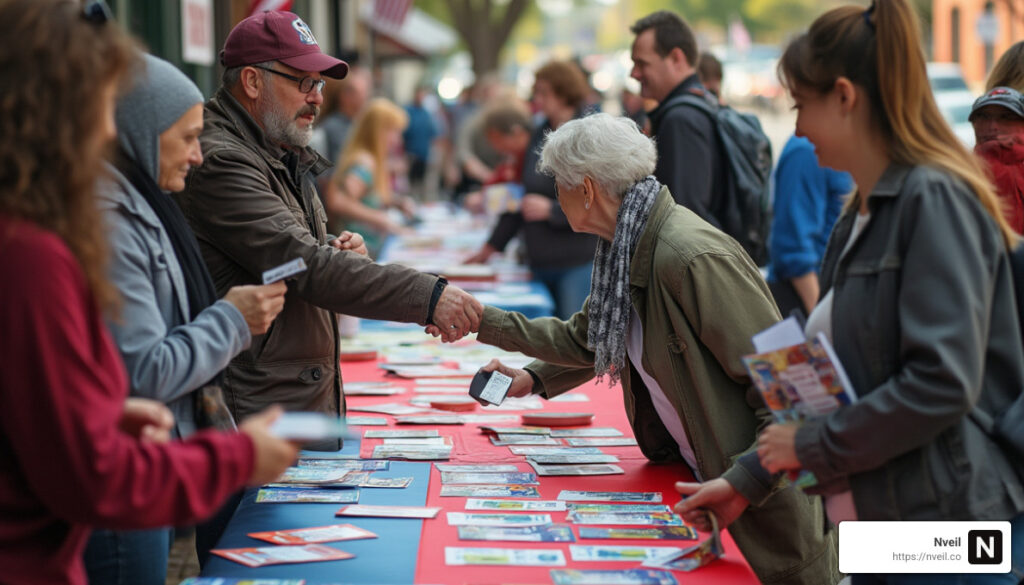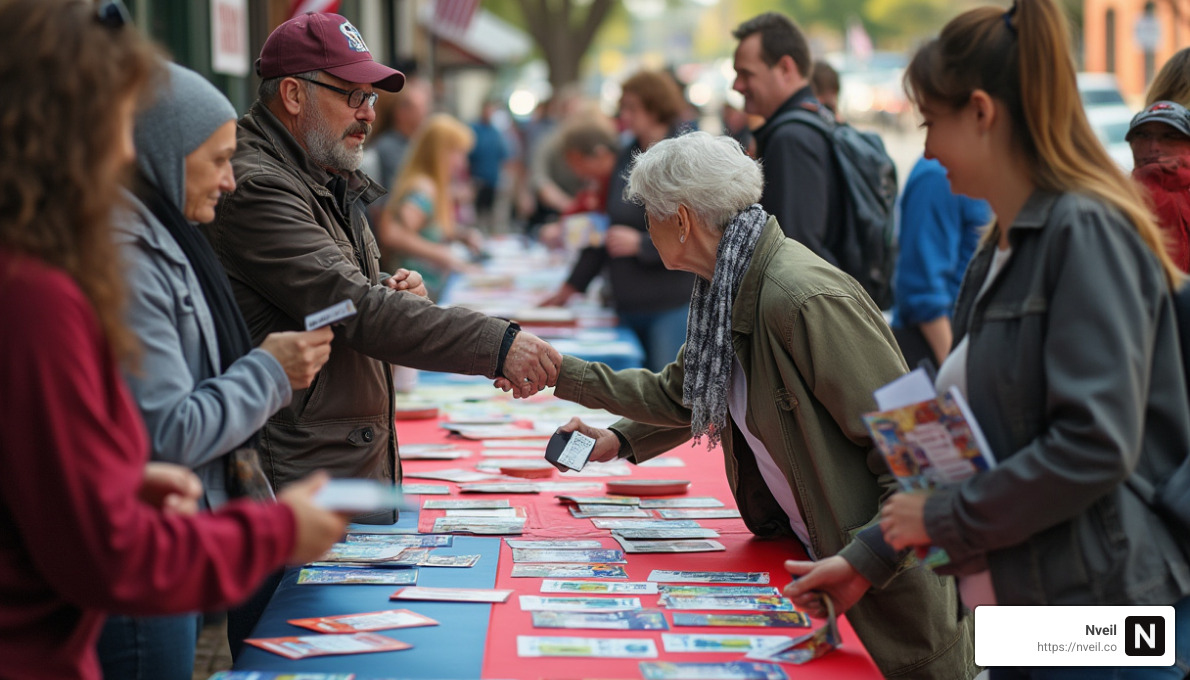
Unlocking Offline Potential: Top Marketing Strategies for 2025
Offline marketing strategies are essential for enhancing brand exposure and engaging with customers beyond the digital realm. While digital marketing often takes the spotlight today, traditional media such as television, radio, and print still provide a powerful way to reach a diverse and broad audience. Whether you’re a small business owner aiming to expand your reach or a growing company looking to strengthen your brand identity, these strategies offer a wealth of opportunities.
Here’s a quick rundown of effective offline marketing strategies:
- Business Cards: Enhance networking efforts with memorable designs that reflect your brand.
- Pamphlets and Flyers: Distribute informative content to boost local visibility.
- Community Engagement: Build connections through volunteer work and sponsorships.
- Trade Shows: Be seen and heard; meaningful interactions lead to new opportunities.
- Cross-Promotion: Collaborate with like-minded businesses to tap into broader markets.
Offline marketing isn’t just about advertisements; it’s about creating tangible bonds and enriching your brand’s presence at every touchpoint. By blending both online and offline efforts, brands can craft more cohesive, impactful campaigns that resonate with their audience.
I’m Reem Musleh, dedicated to helping small and medium-sized businesses navigate the dynamic landscape of offline marketing strategies. Combining years of expertise in branding and digital marketing, I focus on strategic, creative, and straightforward approaches that drive real results.
Understanding Offline Marketing Strategies
You might think traditional marketing is a thing of the past. But offline marketing strategies are alive and well, offering unique ways to build brand awareness and connect with audiences.
Offline marketing techniques include everything from business cards to billboards. They leverage traditional media to reach people in their everyday lives, outside of screens and social media feeds. This approach can make your brand more tangible and memorable.
Traditional Marketing: The Backbone of Brand Awareness
Traditional marketing channels like television, radio, and print are tried and tested. They offer a broad reach, connecting with people who may not spend all their time online. These channels are especially effective for mass advertising and creating a strong brand presence.
Research shows that integrating offline and online marketing can amplify your message. By using both, you create a seamless experience for your audience, enhancing brand recall and trust. For instance, a local TV ad can remind viewers of your brand while your online ads reinforce the message.
Offline Marketing Techniques: Connecting Beyond the Screen
Offline strategies can create personal connections. Consider these techniques:
-
Networking Activities: Attend events where you can meet potential clients face-to-face. A handshake often leaves a lasting impression that digital interactions can’t match.
-
Pamphlets and Flyers: These are cost-effective ways to share your message. Creative designs and informative content can make them worth keeping.
-
Community Engagement: Sponsoring local events or participating in volunteer work can boost your brand’s reputation and visibility.
Offline marketing can also complement your online efforts. For example, a direct mail campaign paired with an email follow-up can significantly increase customer engagement.
By understanding and utilizing these offline marketing strategies, you can improve your brand’s reach and impact, bridging the gap between the digital and physical worlds.
Top Offline Marketing Strategies for 2025
As we step into 2025, let’s explore some of the top offline marketing strategies that can help your business stand out.
Business Cards: A Timeless Tool
Business cards remain a staple in the marketing toolkit. They’re small but mighty, serving as a physical reminder of your brand. A well-designed card can set you apart from the competition.
Design Tips for Business Cards:
- Consistency: Use the same logo, fonts, and colors as your online platforms to ensure brand consistency.
- Unique Design: Consider using colored cardboard or changing the orientation to portrait for a fresh look.
- Key Information: Include essential details like your contact info and website.
Pamphlets and Flyers: Old but Gold
Pamphlets and flyers are still effective in grabbing attention, especially in local markets. They’re great for trade shows or community events.
Creative Designs and Informative Content:
- Infographics: Use visual data to make your pamphlets informative and engaging.
- Discount Coupons: Add value by including coupons to encourage potential customers to keep them.
- Contact Details: Always provide a way for customers to reach you.
Community Engagement: Building Local Connections
Engaging with your community can significantly boost your brand’s reputation. People love supporting local businesses that contribute to the community.
Ways to Engage:
- Volunteer Work: Participate in local charity events or clean-up drives.
- Sponsorships: Support local sports teams or events.
- Local Events: Host or participate in events to foster community relationships.
Trade Shows: Networking and Exposure
Trade shows are fantastic for networking and gaining industry insights. They provide a platform to showcase your products and meet potential clients.
Maximizing Trade Show Presence:
- Booth Design: Make your booth inviting with eye-catching graphics and displays.
- Lead Generation: Collect contact information from visitors for future follow-ups.
- Industry Connections: Use the opportunity to learn from other industry leaders.
Cross-Promotion: Partnering for Success
Cross-promotion involves partnering with other businesses to reach a broader audience. It can be a win-win for both parties involved.
Successful Cross-Promotion Tactics:
- Shared Values: Partner with brands that share your values for authentic collaborations.
- Co-Branded Products: Create products that feature both brands, offering something unique to customers.
- Promotional Partnerships: Host joint events or campaigns to leverage each other’s customer base.
By integrating these offline marketing strategies, your business can create a well-rounded approach that complements your online efforts, ensuring a broader reach and deeper connections with your audience.
Business Cards: A Timeless Tool
Business cards have stood the test of time in offline marketing strategies. Despite the digital shift, these small pieces of cardstock remain powerful networking tools. They serve as a physical connection between you and potential clients or partners.
Design Tips
A business card’s design is crucial. It should reflect your brand’s identity and professionalism.
-
Brand Consistency: Ensure your card mirrors your brand’s colors, fonts, and logo. This consistency helps reinforce your brand’s image across different platforms.
-
Minimalistic Approach: Keep the design clean and straightforward. Avoid cluttering with too much information. A sleek design makes it easier for recipients to remember your brand.
-
Innovative Elements: Consider using textured paper or embossing to make your card stand out. A unique card is more likely to be remembered and kept.
Networking Power
Business cards are more than just contact information. They are conversation starters and networking improvers.
-
First Impressions: Handing over a well-designed card leaves a lasting impression. It’s a tangible representation of your brand and professionalism.
-
Easy Exchange: In networking events or spontaneous meetings, a business card is an easy way to exchange contact details without needing digital devices.
-
Follow-Up Opportunities: Cards often lead to follow-up conversations. They give recipients a reason to reach out, whether it’s to discuss potential collaborations or seek your services.
Key Information
Make sure your business card includes essential details that allow others to connect with you easily.
-
Contact Information: Include your name, phone number, email address, and job title.
-
Online Presence: Add your website or social media handles to provide more ways for people to learn about your business.
-
Clear Messaging: If space allows, include a brief tagline or mission statement that encapsulates what your business offers.
By following these tips, your business cards will not only serve as a vital part of your offline marketing strategies but also improve your networking efforts and brand recognition.
Pamphlets and Flyers: Old but Gold
You might think pamphlets and flyers are outdated. But these offline marketing strategies remain effective, especially for boosting local visibility and delivering informative content.
Creative Designs
Pamphlets and flyers should be eye-catching and memorable. A creative design can set your material apart from the rest.
-
Unique Layouts: Break away from the standard templates. Try different shapes, folds, or sizes to make your pamphlet stand out.
-
Vibrant Colors: Use bold colors that align with your brand’s identity. Colors can evoke emotions and draw attention.
-
Graphics and Images: Incorporate high-quality visuals. Images can convey messages faster than text and make your content more engaging.
Local Visibility
Pamphlets and flyers are perfect for reaching local audiences. They can be distributed in strategic locations to maximize exposure.
-
Community Centers: Place your flyers in libraries, community boards, or local cafes where people gather.
-
Events and Trade Shows: Hand out pamphlets at local events. This direct approach can lead to immediate customer engagement.
-
Door-to-Door Distribution: For a more targeted approach, consider delivering flyers directly to homes in your area.
Informative Content
While design attracts attention, content holds it. Ensure your pamphlets and flyers are packed with valuable information.
-
Concise Messaging: Keep your text short and to the point. Highlight key benefits and features of your product or service.
-
Call-to-Action: Encourage readers to take action, whether it’s visiting your website, attending an event, or contacting you for more information.
-
Contact Details: Always include your business’s contact information, such as phone number, email, and social media handles, to make it easy for potential customers to reach you.

Incorporating these elements into your pamphlets and flyers ensures they remain a powerful part of your offline marketing strategies. They not only improve your brand’s local presence but also provide a tangible way to communicate with your audience.
Community Engagement: Building Local Connections
Community engagement is a cornerstone of effective offline marketing strategies. By actively participating in your local area, you not only improve your brand’s visibility but also foster goodwill and trust. Let’s explore how volunteer work, sponsorships, and local events can boost your business.
Volunteer Work
Volunteering is more than just giving back; it’s about building relationships.
-
Team Efforts: Encourage your employees to volunteer together. This not only strengthens team bonds but also showcases your commitment to community welfare.
-
Skill-Based Volunteering: Use your team’s skills to benefit local nonprofits. For example, if you’re in tech, offer to update a charity’s website or provide IT support.
-
Visibility: Wear branded apparel during volunteer activities to subtly promote your business.
Sponsorships
Sponsorships are a great way to get your brand noticed while supporting local causes.
-
Sports Teams: Sponsor local sports teams. Provide them with branded uniforms and gear. This puts your logo in front of a large audience during games and events.
-
Community Projects: Partner with community projects that align with your brand values. This could be anything from environmental clean-ups to educational programs.
-
Mutual Promotion: Work with sponsored groups to promote each other on social media and in newsletters.
Local Events
Hosting or participating in local events connects you directly with potential customers.
-
Host Your Own Event: Create events like workshops or open houses. These provide an opportunity to showcase your products and services directly to your community.
-
Participate in Fairs and Festivals: Set up a booth at local fairs. Offer interactive experiences or giveaways to draw people in.
-
Collaborate with Other Businesses: Join forces with other local businesses to co-host events. This can expand your reach and introduce your brand to new audiences.
By engaging in these activities, your business can build strong local connections, enhancing both your brand’s reputation and customer loyalty. This form of offline marketing strategy not only promotes your business but also enriches the community, creating a win-win situation for everyone involved.
Trade Shows: Networking and Exposure
Trade shows are a powerful tool in your offline marketing strategies arsenal. They offer a unique opportunity to showcase your brand, connect with industry peers, and generate valuable leads. Let’s explore how you can make the most of trade shows through effective booth design, lead generation techniques, and building industry connections.
Booth Design
Your booth is your brand’s first impression at a trade show. Make it count.
-
Visual Appeal: Use bold colors and clear signage. A well-designed booth can attract attention from afar and draw attendees in.
-
Interactive Elements: Incorporate touchscreens or product demonstrations. Engaging visitors with hands-on experiences can leave a lasting impression.
-
Brand Consistency: Ensure your booth reflects your brand’s identity. Consistent branding across all materials reinforces brand recognition.
Lead Generation
Trade shows are a goldmine for leads if approached strategically.
-
Gimmicks and Giveaways: Offer free samples or discount codes. Incentives can encourage visitors to provide their contact information.
-
Contact Forms: Have simple forms or digital tablets available for collecting leads. Make sure the process is quick and easy.
-
Follow-Up Plan: Reach out to collected leads within a week. A timely follow-up can convert interest into action.
Industry Connections
Building relationships at trade shows can open doors to new opportunities.
-
Networking Events: Attend social events or mixers. These informal settings are perfect for connecting with industry professionals.
-
Panel Discussions: Participate or simply listen in. These sessions can provide insights into industry trends and introduce you to thought leaders.
-
Business Cards: Exchange business cards with new contacts. This traditional tool still holds significant value in establishing connections.
By focusing on these aspects, trade shows can become a cornerstone of your offline marketing strategy. They not only help in showcasing your offerings but also in building meaningful relationships that can drive your business forward.
Next, we’ll explore how cross-promotion can partner you with other businesses for mutual success.
Cross-Promotion: Partnering for Success
Cross-promotion is a strategy where two or more businesses collaborate to reach a wider audience. By leveraging shared values and creating co-branded products, businesses can tap into each other’s customer bases and improve brand visibility. Let’s explore how you can use cross-promotion to your advantage.
Shared Values
Finding partners with similar values is crucial for successful cross-promotion.
-
Aligning Missions: Choose partners whose missions align with yours. This ensures authenticity in your promotions and resonates well with both audiences.
-
Complementary Offerings: Look for businesses that offer complementary products or services. For instance, a local fitness studio might partner with a health food café, as they both cater to health-conscious customers.
-
Community Involvement: Collaborate on community projects. By working together on local initiatives, you can build goodwill and strengthen community ties.
Co-Branded Products
Creating co-branded products can be a win-win for both businesses involved.
-
Unique Offerings: Develop exclusive products that highlight the strengths of both brands. This can attract customers who are loyal to either brand and introduce them to the partner brand.
-
Shared Resources: Pool resources for product development. This can reduce costs and increase the quality of the final product.
-
Joint Marketing: Promote co-branded products through joint marketing efforts. Use both brands’ channels to maximize reach and impact.
Promotional Partnerships
Promotional partnerships can amplify your marketing efforts and drive sales.
-
Event Sponsorships: Co-sponsor events that align with your brand values. This not only shares costs but also increases exposure for both brands.
-
Bundle Deals: Offer bundled deals featuring products from both brands. This provides added value to customers and can boost sales for both businesses.
-
Shared Campaigns: Run joint marketing campaigns. By combining budgets and creative efforts, you can create more impactful promotions.
Cross-promotion is a powerful offline marketing strategy that can improve brand credibility and expand your reach. By selecting the right partners and creating meaningful collaborations, you can achieve mutual success and strengthen your market presence.
Next, we’ll dive into frequently asked questions about offline marketing strategies to further clarify their role and benefits.
Frequently Asked Questions about Offline Marketing Strategies
What are offline marketing strategies?
Offline marketing strategies involve using traditional media to reach potential customers outside the digital world. This includes methods like business cards, pamphlets, and community engagement. These strategies are important for customer acquisition, especially for reaching audiences who may not be as active online.
For example, a local bakery might use flyers to announce a new product, attracting foot traffic directly to their store. Offline methods help businesses engage with their community and establish a physical presence that complements their online efforts.
How do offline and online marketing work together?
Offline and online marketing can create powerful multichannel campaigns. By combining both approaches, businesses ensure better brand consistency across all platforms. For instance, a company might use a billboard to promote a hashtag campaign, encouraging people to engage online and offline.
These integrated strategies provide multiple touchpoints for customers, increasing the chances of engagement and conversion. As noted in the research, combining offline tactics like TV spots with digital ads can significantly boost campaign effectiveness, enhancing both online and offline visibility.
Why is offline marketing still relevant?
Despite the rise of digital marketing, offline marketing remains crucial due to its tangible experiences and local engagement. Tangible materials like brochures and business cards give customers something physical to hold, making the brand more memorable.
Moreover, offline marketing can foster stronger community connections. By participating in local events or sponsoring community projects, businesses can build trust and loyalty among local customers. This local presence helps establish credibility and reassures customers that the business is real and reliable, as highlighted by experts in the research.
Offline strategies offer unique benefits that digital channels alone can’t provide, making them an essential part of a comprehensive marketing plan.
Next, we’ll explore how these offline tactics can be integrated into a cohesive marketing strategy to open up their full potential.
Conclusion
At Nveil, we believe in the power of integrated strategies that harness both online and offline marketing to open up a brand’s full potential. Offline marketing is not just a relic of the past—it’s a dynamic way to connect with people on a personal level and create lasting impressions.
In today’s digital world, it’s easy to overlook the impact of a well-designed business card or a thoughtfully crafted pamphlet. Yet, these tools can be the key to tangible experiences that digital interactions often lack. They serve as physical reminders of your brand, helping to bridge the gap between the virtual and the real world.
Community engagement is another essential component of offline marketing. By participating in local events or sponsoring community initiatives, businesses can build genuine relationships with their audience. This local presence not only improves credibility but also fosters trust and loyalty, which are crucial for long-term success.
Moreover, trade shows offer unparalleled opportunities for networking and exposure. They allow businesses to showcase their offerings, generate leads, and forge industry connections. A well-executed trade show strategy can amplify your brand’s reach and open doors to new markets.
Finally, cross-promotion with like-minded partners can expand your brand’s visibility and reach. By collaborating with other businesses that share your values, you can create co-branded products and promotional partnerships that resonate with a wider audience.
At Nveil, we are committed to helping businesses integrate these offline strategies with their online efforts to create cohesive, impactful campaigns. By leveraging both fields, we can help you connect with customers in meaningful ways, ultimately driving growth and success.
Incorporating offline marketing into your overall strategy is not just about keeping up with the times—it’s about staying ahead of the curve. Let’s open up the potential of offline marketing together and pave the way for a brighter future.



